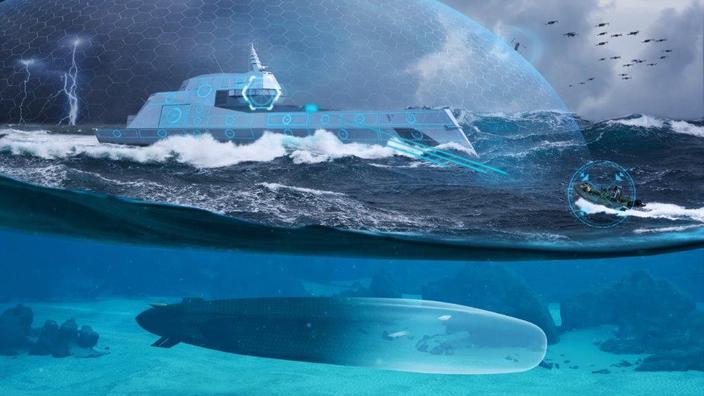Touched but not sunk.
After the shock created by the cancellation by Australia of the “
contract of the century
” in submarines in mid-September, Naval Group was keen to demonstrate that it was staying the course in order to remain at the forefront of innovation.
The European leader in military naval is actively working on the naval combat of the future, which will be connected within a digital bubble, and of high intensity.
The Marines will have to implement "
invulnerable ships
", drones, robotic devices as well as new generation propulsion systems.
Read alsoSubmarine crisis: the president of Naval Group breaks the silence
During its 5th Innovation Days, Naval Group presented, this Thursday, October 7, 12 innovations likely to revolutionize the way of waging war on and under the oceans by countering new threats such as drone swarms or missiles. supersonic.
Autonomous surveillance mission in 2022
The flagship of this work is a demonstrator of a large oceanic underwater drone, developed with own funds for five years, in partnership with Thales, which supplies sonar, and the start-up Delfox, a specialist in artificial intelligence (AI).
The machine, autonomous, is able to reconfigure its mission and its trajectory, according to the evolution of the situation, thanks to its on-board AI, which gives it "
decision-making autonomy
".
This drone will be used for intelligence, protection, underwater detection missions in the service of a carrier strike group, surface ships and submarines.
A first demonstrator - 10 tonnes on the scale, 10 meters long - carried out a first test campaign, in February 2021, off Toulon.
The next stage is scheduled for 2022 with the engagement of the drone in an autonomous surveillance mission.
Read alsoDrones war: "
Faced with the threat, we must not be helpless
"
Unlike current drones, which remain close to ships, this oceanic drone "
will give length
", according to the expression of Pierre-Éric Pommellet, CEO of Naval Group, "as
well as additional observation and defense capabilities.
»To the Marines who will equip them. Oceanic drones will be able to carry out missions, of several thousand kilometers, for several weeks, in complete autonomy. "
These will not be tele-operated drones, with a thread to the leg
", explains Eric Papin, Director of Innovation at Naval Group.
If the tests are conclusive, a first oceanic drone could enter service in the French Navy, with which the company will open discussions, by 2025. By then, Naval Group must have decided on the mode of propulsion of this drone which could run on hydrogen instead of Diesel-electric batteries, as is the case for conventional submarines.
Hydrogen-based propulsion
Improving energy efficiency and reducing polluting emissions are also part of Naval Group's technological roadmap. The latter is working in partnership with Saft on the development of Lithium-Ion batteries. He also qualified an immersion energy production system (AIP) which recharges the batteries of ships and submarines with conventional propulsion (Diesel-electric). “
These AIPs are ready to be integrated on our customers
'
boats
,” explains Eric Papin. These systems give boats almost unlimited autonomy, until hydrogen-based solutions are developed.
Another field of innovation, swarms of drones.
“
They can constitute a saturating type threat, but we can also use them to our advantage to respond to this type of threat,
” explains Eric Papin.
Naval Group is also developing demonstrators, in partnership with start-ups, to test how to detect hostile swarms and how to neutralize them using lasers.
Another major innovation is the development of aerial drones launched from a submarine.
Cybersecurity and embedded servers
Finally, the group presented several solutions allowing technological innovation to be brought on board existing boats, via software updates. “
Like combat aircraft, frigates, for example, will switch from one standard to another. This is the case of the intervention and defense frigates (FDI) which constitute the demonstrator of innovation. For the first time, all combat functions are integrated is in a separate block. All of its information systems are on embedded servers. The cybersecurity of the vessel is ensured by design. The radar has flat panels, the entire system is managed electronically, ”
explains Pierre-Éric Pommellet.
Integrated within a cyber-protected digital bubble, all players in naval combat must be interoperable and “
invulnerable
”, summarizes Naval Group.

